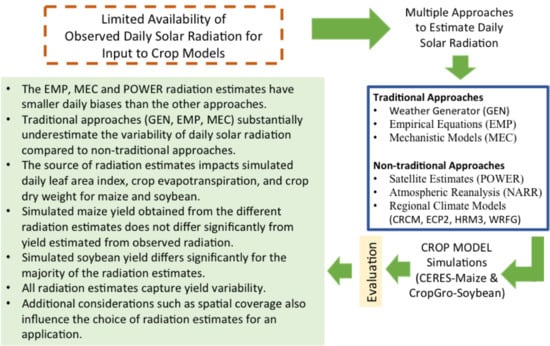Evaluation of Multiple Approaches to Estimate Daily Solar Radiation for Input to Crop Process Models
Abstract
1. Introduction
2. Materials and Methods
2.1. Climate Observations and Study Period
2.2. Daily Solar Radiation Estimates
2.2.1. Stochastic Generation
2.2.2. Empirical Model
2.2.3. Mechanistic Model
2.2.4. Satellite Radiation Estimates
2.2.5. Reanalysis Radiation Estimates
2.2.6. Regional Climate Model Simulations
2.3. Crop Yield Simulations
2.4. Evaluation Methods
2.4.1. Daily Solar Radiation
2.4.2. Crop Growth and Development
2.4.3. Crop Yield
3. Results
3.1. Solar Radiation
3.2. Crop Growth and Development
3.2.1. Accumulated Daily Solar Radiation (SRAC)
3.2.2. Leaf Area Index (LAID)
3.2.3. Accumulated Crop Evapotranspiration (ETAC)
3.2.4. Accumulated Crop Dry Weight (CWAD)
3.3. Crop Yield
4. Discussion
5. Conclusions
Author Contributions
Funding
Acknowledgments
Conflicts of Interest
References
- Hoogenboom, G. Contribution of agrometeorology to the simulation of crop production and its applications. Agric. For. Meteorol. 2000, 103, 137–157. [Google Scholar] [CrossRef]
- Jones, J.W.; Hoogenboom, G.; Porter, C.H.; Boote, K.J.; Batchelor, W.D.; Hunt, L.A.; Wilkens, P.W.; Singh, U.; Gijsman, A.J.; Ritchie, J.T. The DSSAT cropping system model. Eur. J. Agron. 2003, 18, 235–265. [Google Scholar] [CrossRef]
- Liu, D.L.; Scott, B.J. Estimation of solar radiation in Australia from rainfall and temperature observations. Agric. For. Meteorol. 2001, 106, 41–59. [Google Scholar] [CrossRef]
- Ruiz-Arias, J.A.; Gueymard, C.A. Worldwide inter-comparison of clear-sky solar radiation models: Consensus-based review of direct and global irradiance components simulated at the earth surface. Sol. Energy 2018, 168, 10–29. [Google Scholar] [CrossRef]
- Leduc, S.; Diamond, H.J.; Palecki, M.A. The United States Climate Reference Network (USCRN) Annual Report for Fiscal Year 2009: US Climate Reference Network; NOAA/NESDIS National Climatic Data Center: Asheville, NC, USA, 2009; p. 32.
- Diamond, H.J.; Karl, T.R.; Palecki, M.A.; Baker, C.B.; Bell, J.E.; Leeper, R.D.; Easterling, D.R.; Lawrimore, J.H.; Meyers, T.P.; Helfert, M.R.; et al. U.S. Climate Reference Network after one decade of operations: Status and assessment. Bull. Am. Meteorol. Soc. 2013, 94, 485–498. [Google Scholar] [CrossRef]
- Augustine, J.A.; Hodges, G.B.; Cornwall, C.R.; Michalsky, J.J.; Medina, C.I. An update on SURFRAD—the GCOS Surface Radiation Budget Network for the Continental United States. J. Atmos. Ocean. Technol. 2005, 22, 1460. [Google Scholar] [CrossRef]
- Augustine, J.A.; DeLuisi, J.J.; Long, C.N. SURFRAD—A National Surface Radiation Budget Network for atmospheric research. Bull. Am. Meteorol. Soc. 2000, 81, 2341–2357. [Google Scholar] [CrossRef]
- Driemel, A.; Augustine, J.; Behrens, K.; Colle, S.; Cox, C.; Cuevas-Agulló, E.; Denn, F.M.; Duprat, T.; Fukuda, M.; Grobe, H.; et al. Baseline Surface Radiation Network (BSRN): Structure and data description (1992–2017). Earth Syst. Sci. Data 2018, 10, 1491–1501. [Google Scholar] [CrossRef]
- Keller, M.; Schimel, D.S.; Hargrove, W.W.; Hoffman, F.M. A continental strategy for the National Ecological Observatory Network. Front. Ecol. Environ. 2008, 6, 282–284. [Google Scholar] [CrossRef]
- Thomas, U.K.; Brian Robert, J.; Michele, A.K.; Michael, K. NEON: The first continental-scale ecological observatory with airborne remote sensing of vegetation canopy biochemistry and structure. J. Appl. Remote Sens. 2010, 4, 1–24. [Google Scholar]
- Apipattanavis, S.; Bert, F.; Podesta, G.; Rajagopalan, B. Linking weather generators and crop models for assessment of climate forecast outcomes. Agric. For. Meteorol. 2010, 150, 166–174. [Google Scholar] [CrossRef]
- Duveiller, G.; Donatelli, M.; Fumagalli, D.; Zucchini, A.; Nelson, R.; Baruth, B. A dataset of future daily weather data for crop modelling over Europe derived from climate change scenarios. Theor. Appl. Climatol. 2017, 127, 573–585. [Google Scholar] [CrossRef]
- Van Wart, J.; Grassini, P.; Yang, H.; Claessens, L.; Jarvis, A.; Cassman, K.G. Creating long-term weather data from thin air for crop simulation modeling. Agric. For. Meteorol. 2015, 209, 49–58. [Google Scholar] [CrossRef]
- Vesely, F.M.; Paleari, L.; Movedi, E.; Bellocchi, G.; Confalonieri, R. Quantifying uncertainty due to stochastic weather generators in climate change impact studies. Sci. Rep. 2019, 9, 9258. [Google Scholar] [CrossRef]
- Richardson, C.W.; Wright, D.A. WGEN: A Model for Generating Daily Weather Variables; US Department of Agriculture, Agricultural Research Service: Springfield, VA, USA, 1984; p. 83.
- Geng, S.; Devries, F.; Supit, I. A simple method for generating daily rainfall data. Agric. For. Meteorol. 1986, 36, 363–376. [Google Scholar] [CrossRef]
- Garcia, A.G.Y.; Hoogenboom, G. Evaluation of an improved daily solar radiation generator for the southeastern USA. Clim. Res. 2005, 29, 91–102. [Google Scholar] [CrossRef][Green Version]
- Woli, P.; Paz, J.O. Evaluation of various methods for estimating global solar radiation in the southeastern United States. J. Appl. Meteorol. Climatol. 2012, 51, 972–985. [Google Scholar] [CrossRef]
- Ball, R.A.; Purcell, L.C.; Carey, S.K. Evaluation of solar radiation prediction models in North America. Agron. J. 2004, 96, 391–397. [Google Scholar] [CrossRef]
- Hunt, L.A.; Kuchar, L.; Swanton, C.J. Estimation of solar radiation for use in crop modelling. Agric. For. Meteorol. 1998, 91, 293–300. [Google Scholar] [CrossRef]
- Kanamitsu, M.; Ebisuzaki, W.; Woollen, J.; Yang, S.-K.; Hnilo, J.J.; Fiorino, M.; Potter, G.L. NCEP DOE AMIP-II Reanalysis (R-2). Bull. Am. Meteorol. Soc. 2002, 83, 1631–1643. [Google Scholar] [CrossRef]
- Gelaro, R.; McCarty, W.; Suárez, M.J.; Todling, R.; Molod, A.; Takacs, L.; Randles, C.A.; Darmenov, A.; Bosilovich, M.G.; Reichle, R.; et al. The Modern-Era Retrospective Analysis for Research and Applications, Version 2 (MERRA-2). J. Clim. 2017, 30, 5419–5454. [Google Scholar] [CrossRef] [PubMed]
- Mesinger, F.; DiMego, G.; Kalnay, E.; Mitchell, K.; Shafran, P.C.; Ebisuzaki, W.; Jović, D.; Woollen, J.; Rogers, E.; Berbery, E.H.; et al. North American Regional Reanalysis. Bull. Am. Meteorol. Soc. 2006, 87, 343–360. [Google Scholar] [CrossRef]
- Jacob, D.; Petersen, J.; Eggert, B.; Alias, A.; Christensen, O.B.; Bouwer, L.M.; Braun, A.; Colette, A.; Déqué, M.; Georgievski, G.; et al. EURO-CORDEX: New high-resolution climate change projections for European impact research. Reg. Environ. Chang. 2014, 14, 563–578. [Google Scholar] [CrossRef]
- Mearns, L.O.; Gutowski, W.; Jones, R.; Leung, R.; McGinnis, S.; Nunes, A.; Qian, Y. A regional climate change assessment program for North America. Eos Trans. AGU 2009, 90, 311. [Google Scholar] [CrossRef]
- White, J.W.; Hoogenboom, G.; Stackhouse, P.W., Jr.; Hoell, J.M. Evaluation of NASA satellite- and assimilation model-derived long-term daily temperature data over the Continental US. Agric. For. Meteorol. 2008, 148, 1574–1584. [Google Scholar] [CrossRef]
- GLRAG. Great Lakes; Atmospheric, Oceanic and Space Sciences Department, University of Michigan: Ann Arbor, MI, USA, 2000; pp. 69–76. [Google Scholar]
- Garcia, A.G.Y.; Guerra, L.C.; Hoogenboom, G. Impact of generated solar radiation on simulated crop growth and yield. Ecol. Model. 2008, 210, 312–326. [Google Scholar] [CrossRef]
- White, J.W.; Hoogenboom, G.; Wilkens, P.W.; Stackhouse, P.W., Jr.; Hoel, J.M. Evaluation of satellite-based, modeled-derived daily solar radiation data for the Continental United States. Agron. J. 2011, 103, 1242–1251. [Google Scholar] [CrossRef]
- Bai, J.; Chen, X.; Dobermann, A.; Yang, H.; Cassman, K.G.; Zhang, F. Evaluation of NASA satellite- and model-derived weather data for simulation of maize yield potential in China. Agron. J. 2011, 102, 9–16. [Google Scholar] [CrossRef]
- Jin, C.; Xiao, X.; Wagle, P.; Griffis, T.; Dong, J.; Wu, C.; Qin, Y.; Cook, D.R. Effects of in-situ and reanalysis climate data on estimation of cropland gross primary production using the vegetation photosynthesis model. Agric. For. Meteorol. 2015, 213, 240–250. [Google Scholar] [CrossRef]
- Abraha, M.G.; Savage, M.J. Comparison of estimates of daily solar radiation from air temperature range for application in crop simulations. Agric. For. Meteorol. 2008, 148, 401–416. [Google Scholar] [CrossRef]
- University of Wisconsin. UW Extension Ag Weather. 2010. Available online: https://agweather.cals.wisc.edu/awon (accessed on 8 December 2020).
- Menne, M.J.; Williams, C.N.; Vose, R.S. The US Historical Climatology Network monthly temperature data, Version 2. Bull. Am. Meteorol. Soc. 2009, 90, 993–1007. [Google Scholar] [CrossRef]
- Pickering, N.B.; Hansen, J.W.; Jones, J.W.; Wells, C.M.; Chan, V.K.; Godwin, D.C. Weatherman: A utility for managing and generating daily weather data. Agron. J. 1994, 86, 332–337. [Google Scholar] [CrossRef]
- Mavromatis, T.; Jagtap, S.S. Estimating solar radiation for crop modeling using temperature data from urban and rural stations. Clim. Res. 2005, 29, 233–243. [Google Scholar] [CrossRef]
- Spitters, C.J.T.; Toussaint, H.; Goudriaan, J. Separating the diffuse and direct component of global radiation and its implications for modeling canopy photosynthesis. 1. Components of incoming radiation. Agric. For. Meteorol. 1986, 38, 217–229. [Google Scholar] [CrossRef]
- Donatelli, M.; Bellocchi, G.; Fontana, F. Radest3.00: Software to estimate daily radiation data from commonly available meteorological variables. Eur. J. Agron. 2003, 18, 363–367. [Google Scholar] [CrossRef]
- NASA. The POWER Project. 2020. Available online: https://power.larc.nasa.gov/ (accessed on 8 December 2020).
- Pinker, R.T.; Laszlo, I. Modeling surface solar irradiance for satellite applications on a global scale. J. Appl. Meteorol. 1992, 31, 194–211. [Google Scholar] [CrossRef]
- NASA. Power Data Methodology. 2019. Available online: https://power.Larc.Nasa.Gov/docs/methodology/ (accessed on 6 October 2020).
- National Center for Environmental Information (NCEI), No Date, North American Regional Reanalysis (NARR). Available online: https://www.ncdc.noaa.gov/data-access/model-data/model-datasets/north-american-regional-reanalysis-narr (accessed on 8 December 2020).
- NARCCAP, North American Regional Climate Change Assessment Program. 2007. Available online: https://www.narccap.ucar.edu/ (accessed on 8 December 2020).
- Mearns, L.O.; Lettenmaier, D.P.; McGinnis, S. Uses of results of regional climate model experiments for impacts and adaptation studies: The example of NARCCAP. Curr Clim Chang. Rep. 2015, 1, 1–9. [Google Scholar] [CrossRef]
- Kalnay, E.; Kanamitsu, M.; Kistler, R.; Collins, W.; Deaven, D.; Gandin, L.; Iredell, M.; Saha, S.; White, G.; Woollen, J.; et al. The NCEP/NCAR 40-year reanalysis project. Bull. Am. Meteorol. Soc. 1996, 77, 437–471. [Google Scholar] [CrossRef]
- Andresen, J.A.; Alagarswamy, G.; Rotz, C.A.; Ritchie, J.T.; LeBaron, A.W. Weather impacts on maize, soybean, and alfalfa production in the Great Lakes region, 1895–1996. J. Agron. 2001, 93, 1059–1070. [Google Scholar] [CrossRef]
- Rivington, M.; Bellocchi, G.; Matthews, K.B.; Buchan, K. Evaluation of three model estimations of solar radiation at 24 UK stations. Agric. For. Meteorol. 2005, 132, 228–243. [Google Scholar] [CrossRef]
- Kobayashi, K.; Salam, M.U. Comparing simulated and measured values using mean squared deviation and its components. Agron. J. 2000, 92, 345–352. [Google Scholar] [CrossRef]
- Winkler, J.A.; Guentchev, G.S.; Perdinan; Tan, P.-N.; Zhong, S.; Liszewska, M.; Abraham, Z.; Niedźwiedź, T.; Ustrnul, Z. Climate scenario development and applications for local/regional climate change impact assessments: An overview for the non-climate scientist. Geogr. Compass 2011, 5, 275–300. [Google Scholar] [CrossRef]
- Wilby, R.L.; Dawson, C.W.; Barrow, E.M. SDSM-A decision support tool for the assessment of regional climate change impacts. Environ. Model. Softw. 2002, 17, 145–157. [Google Scholar] [CrossRef]
- Wilks, D.S. Adapting stochastic weather generation algorithms for climate change studies. Clim. Chang. 1992, 22, 67–84. [Google Scholar] [CrossRef]
- Hersbach, H.; Bell, B.; Berrisford, P.; Hirahara, S.; Horányi, A.; Muñoz-Sabater, J.; Nicolas, J.; Peubey, C.; Radu, R.; Schepers, D.; et al. The ERA5 Global Reanalysis. Q. J. R. Meteorol. Soc. 2020, 146, 1999–2049. [Google Scholar] [CrossRef]
- Babar, B.; Graversen, R.; Boström, T. Solar radiation estimation at high latitudes: Assessment of the CMSAF databases, ASR and ERA5. Sol. Energy 2019, 182, 397–411. [Google Scholar] [CrossRef]
- Wang, K.; Clow, G.D. Newly collected data across Alaska reveal remarkable biases in solar radiation products. Int. J. Climatol. 2020, 1–16. [Google Scholar] [CrossRef]
- Giorgi, F.; Jones, C.; Asrar, G.R. Addressing climate information needs at the regional level: The CORDEX framework. Bull. World Meteorol. Organ. 2009, 58, 175–183. [Google Scholar]
- Afshin, S.; Gerrit, H. Minimum data requirements for parameter estimation of stochastic weather generators. Clim. Res. 2003, 25, 109–119. [Google Scholar]
- Markovic, M.; Jones, C.G.; Winger, K.; Paquin, D. The surface radiation budget over North America: Gridded data assessment and evaluation of regional climate models. Int. J. Climatol. 2009, 29, 2226–2240. [Google Scholar] [CrossRef]
- Kumar, S.; Merwade, V. Evaluation of NARR and CLM3.5 outputs for surface water and energy budgets in the Mississippi River Basin. J. Geophys. Res. Atmos. 2011, 116, 1–21. [Google Scholar] [CrossRef]
- Schroeder, T.A.; Hember, R.; Coops, N.C.; Liang, S. Validation of solar radiation surfaces from MODIS and reanalysis data over topographically complex terrain. J. Appl. Meteorol. Climatol. 2009, 48, 2441–2458. [Google Scholar] [CrossRef]
- Tarasova, T.A.; Fernandez, J.P.R.; Pisnichenko, I.A.; Marengo, J.A.; Ceballos, J.C.; Bottino, M.J. Impact of new solar radiation parameterization in the Eta model on the simulation of summer climate over South America. J. Appl. Meteorol. Climatol. 2006, 45, 318–333. [Google Scholar] [CrossRef]

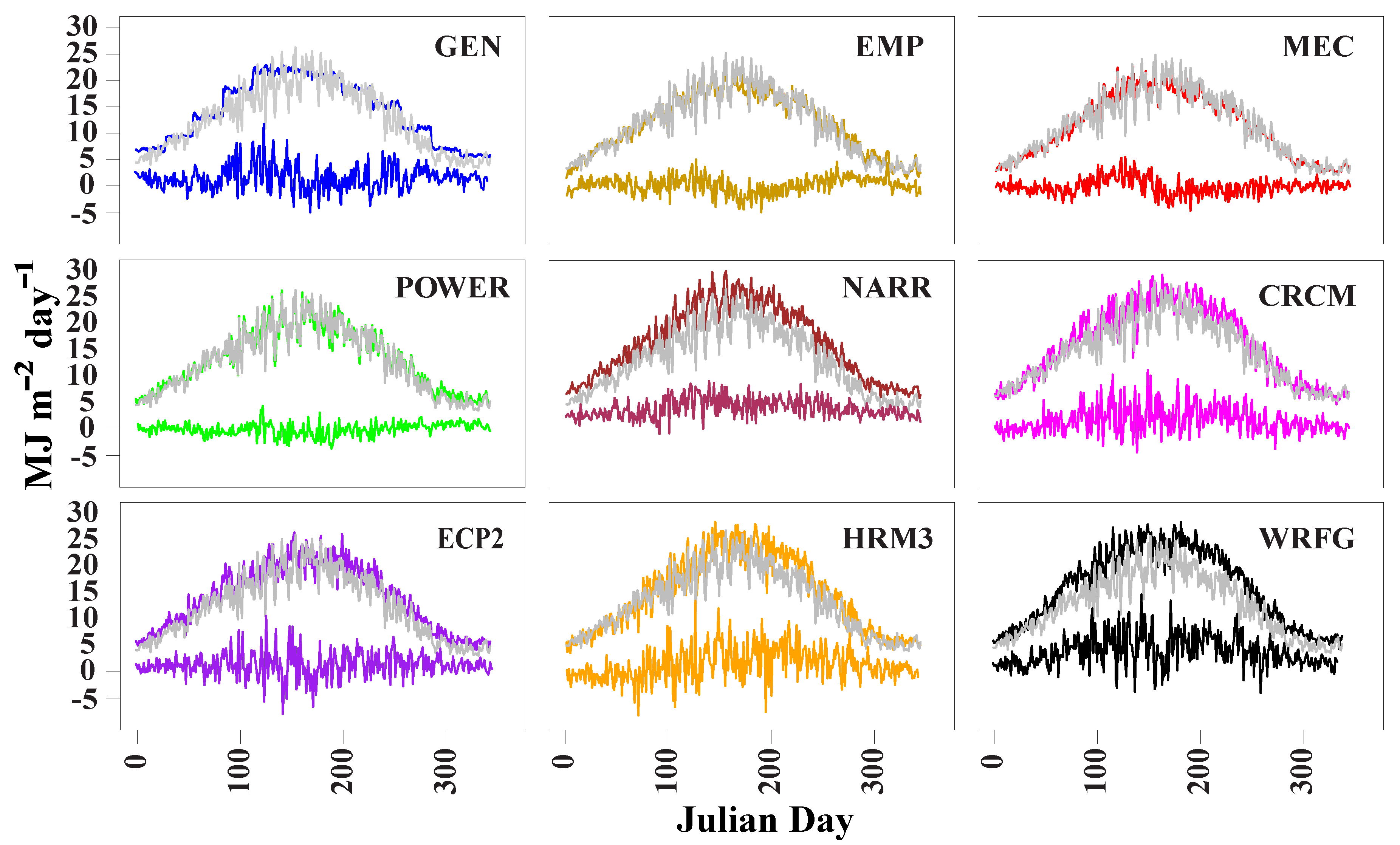
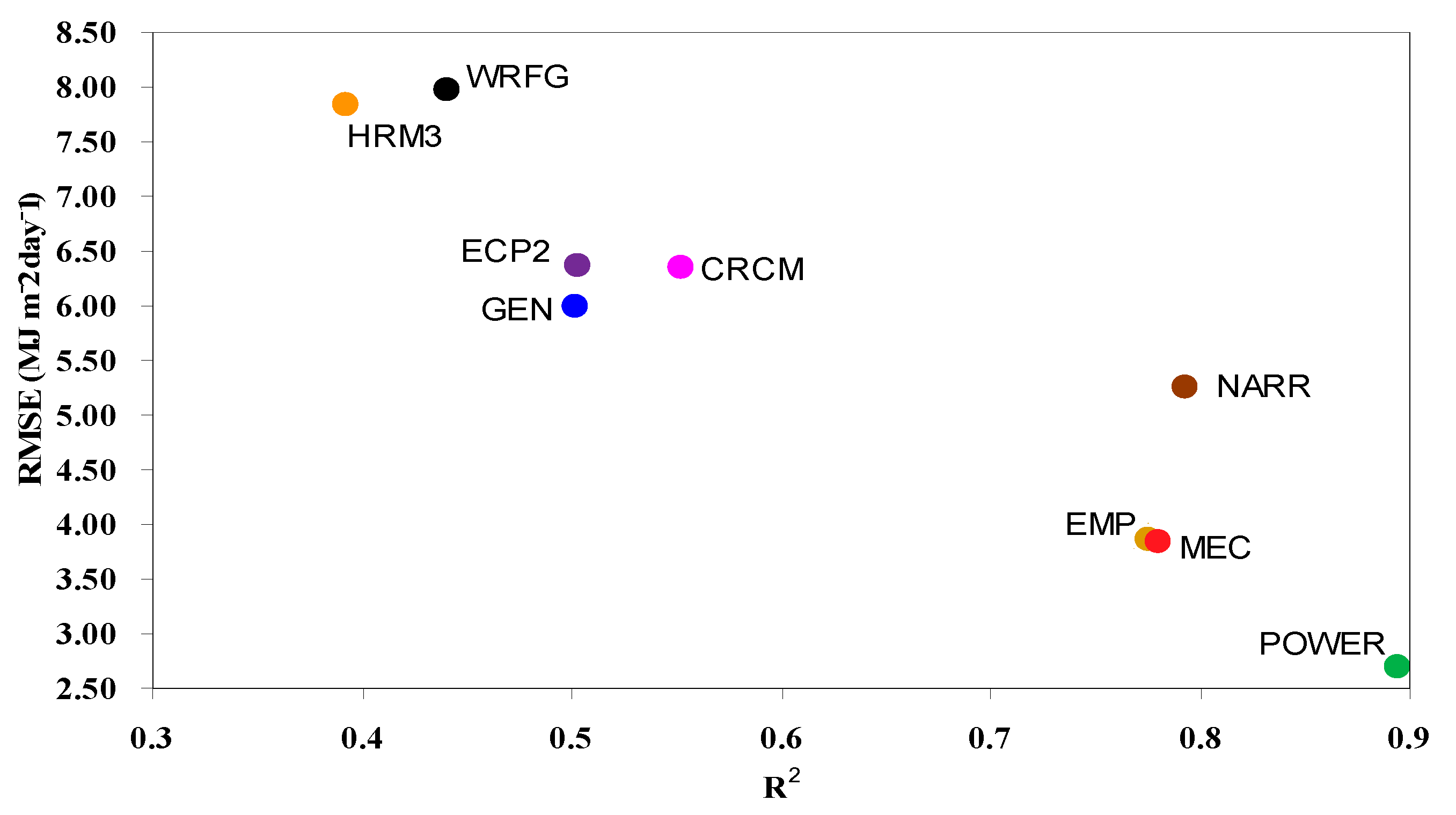
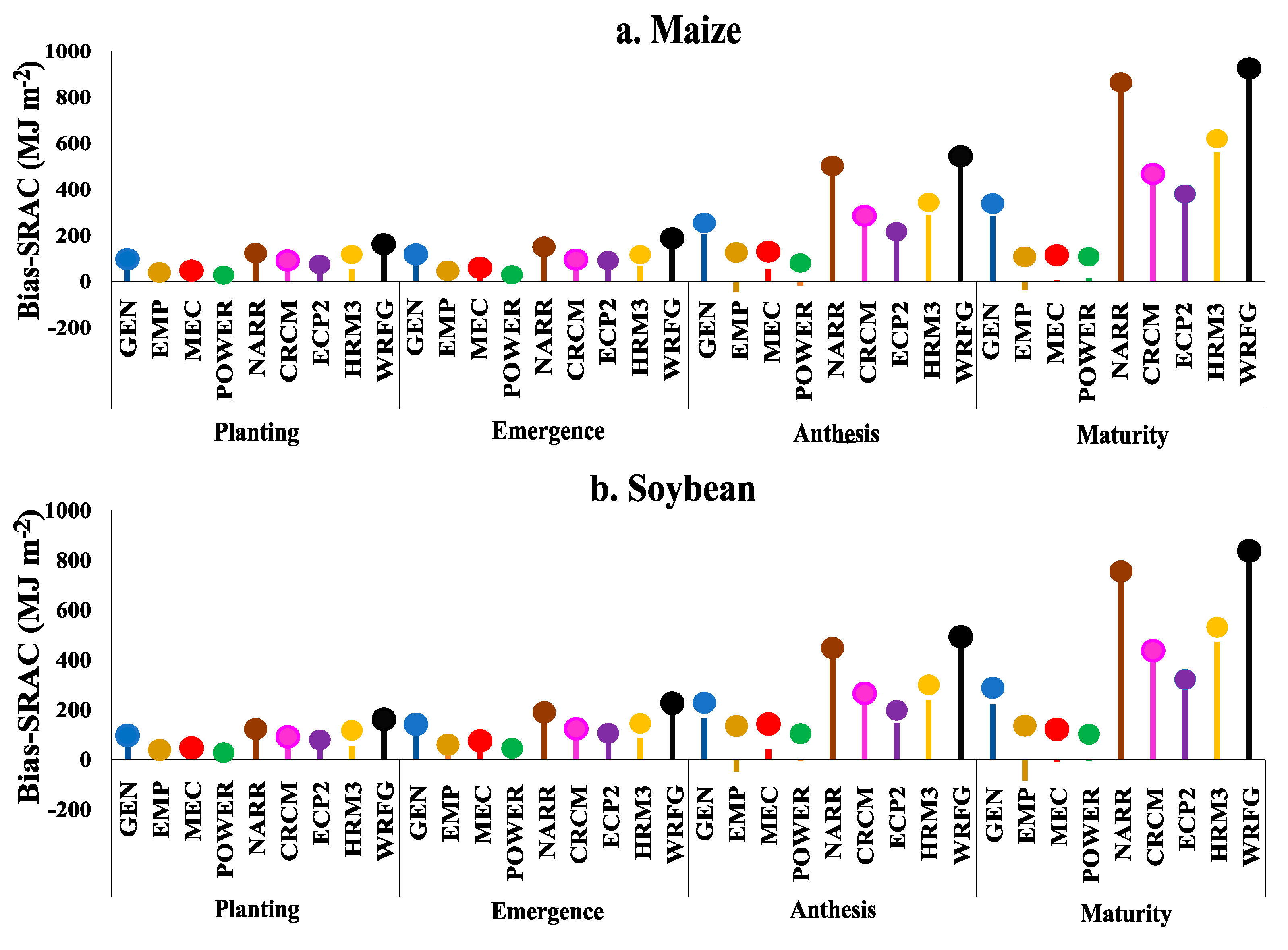
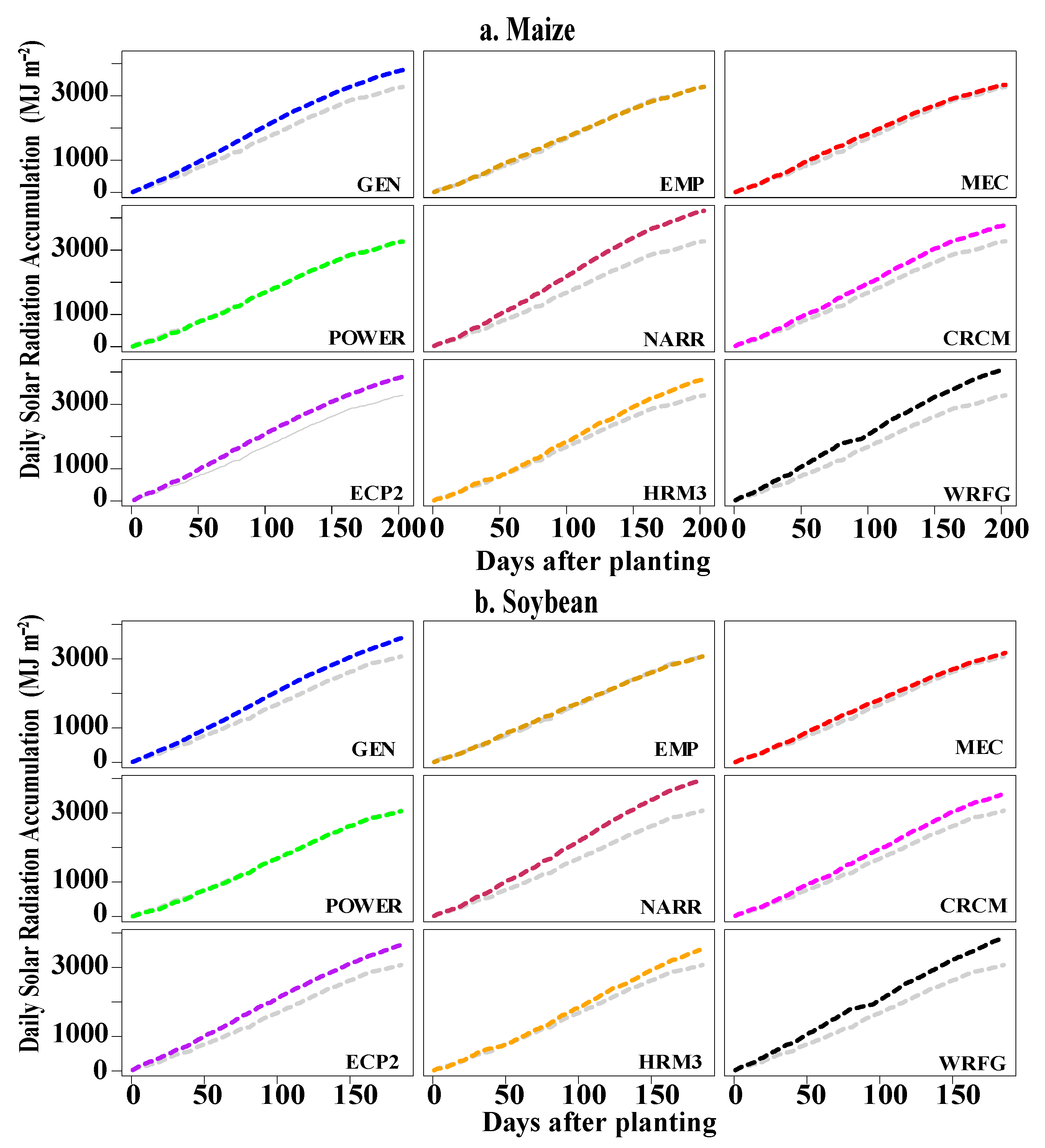
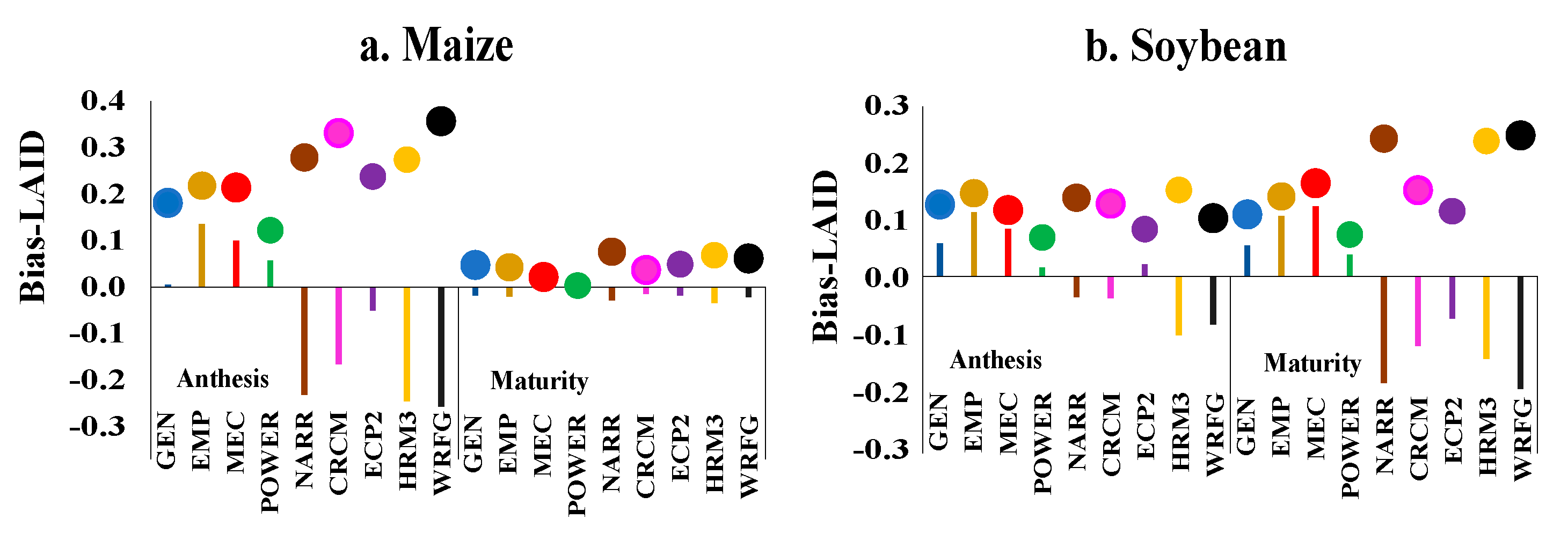
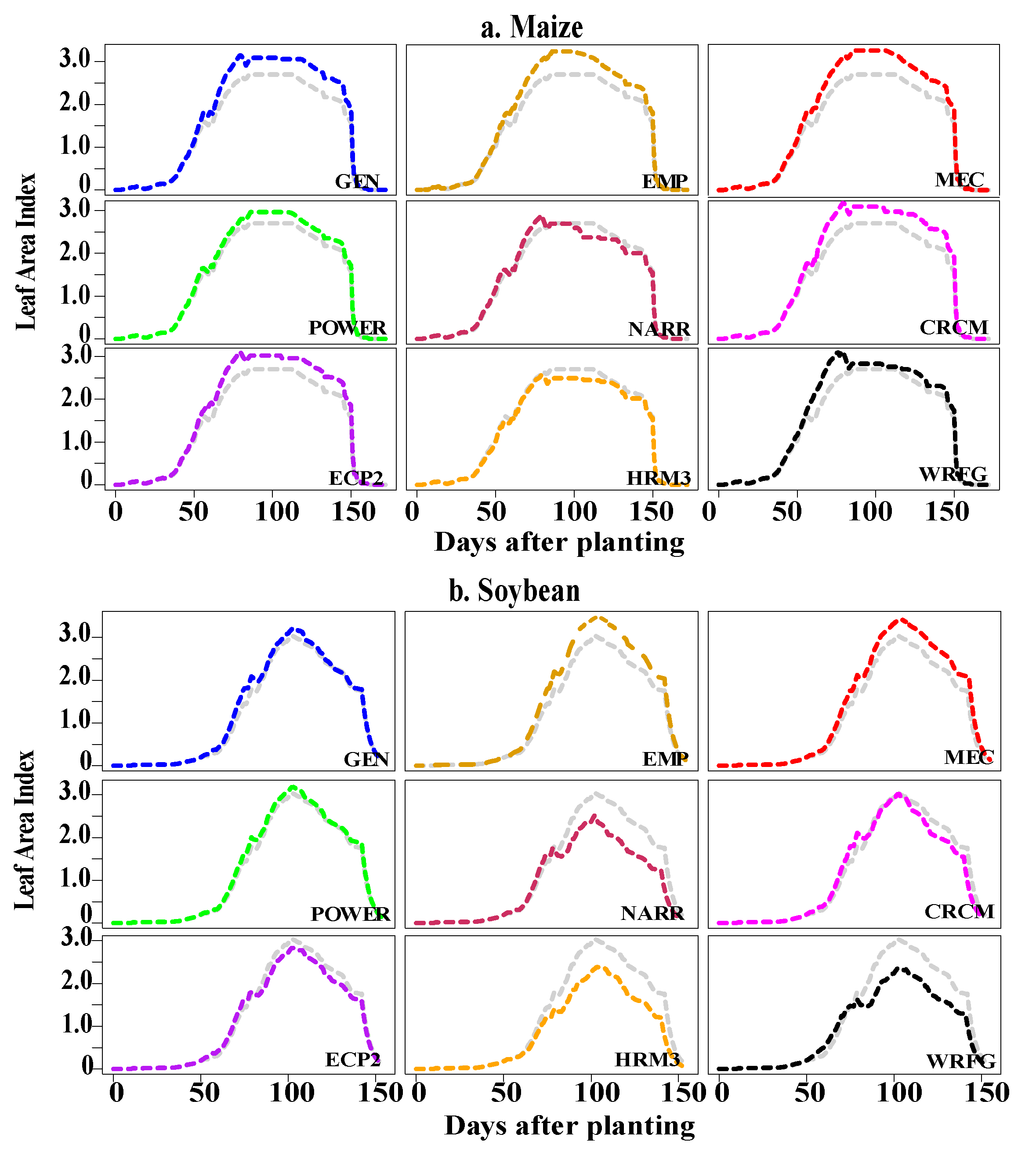
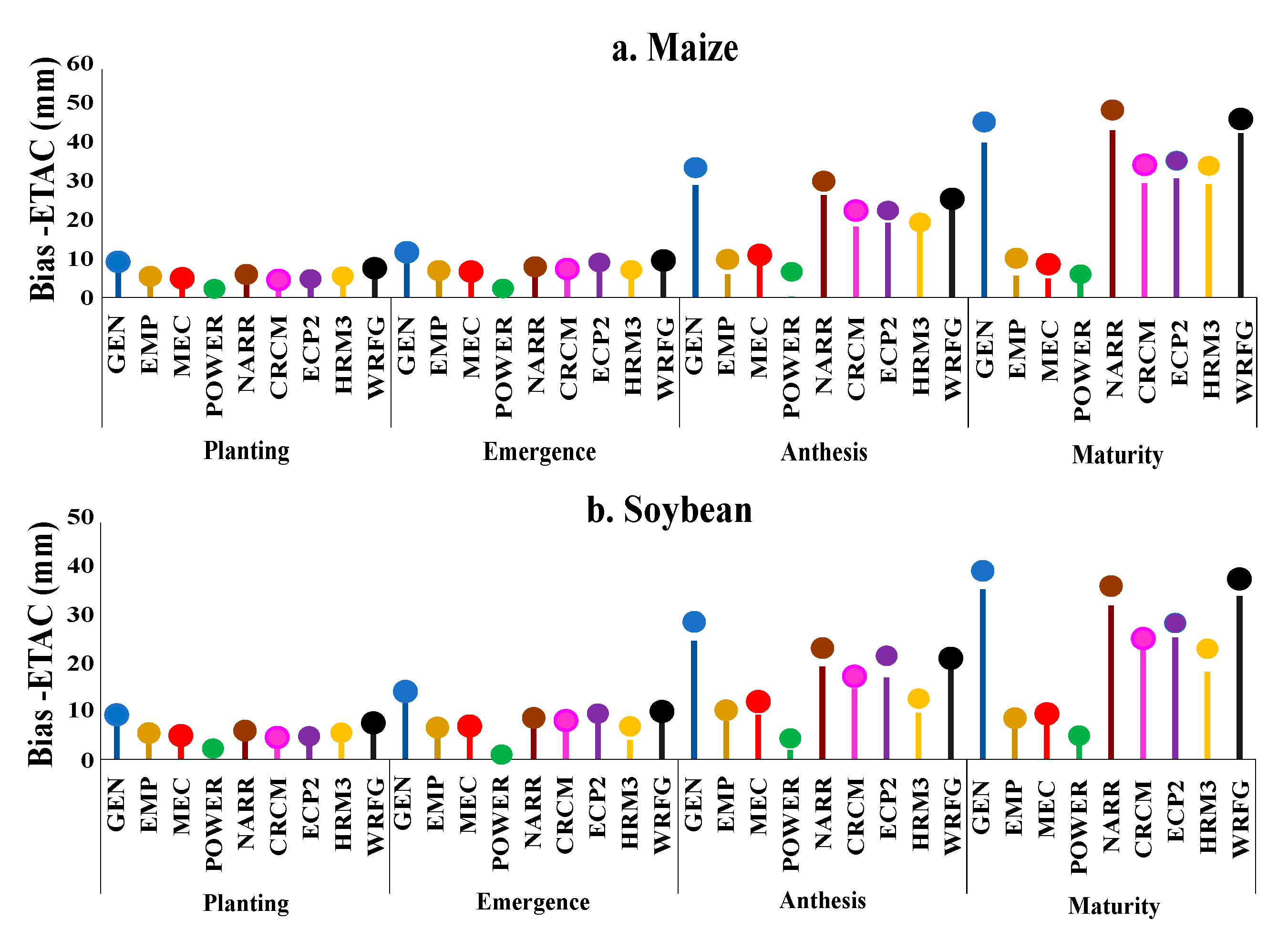


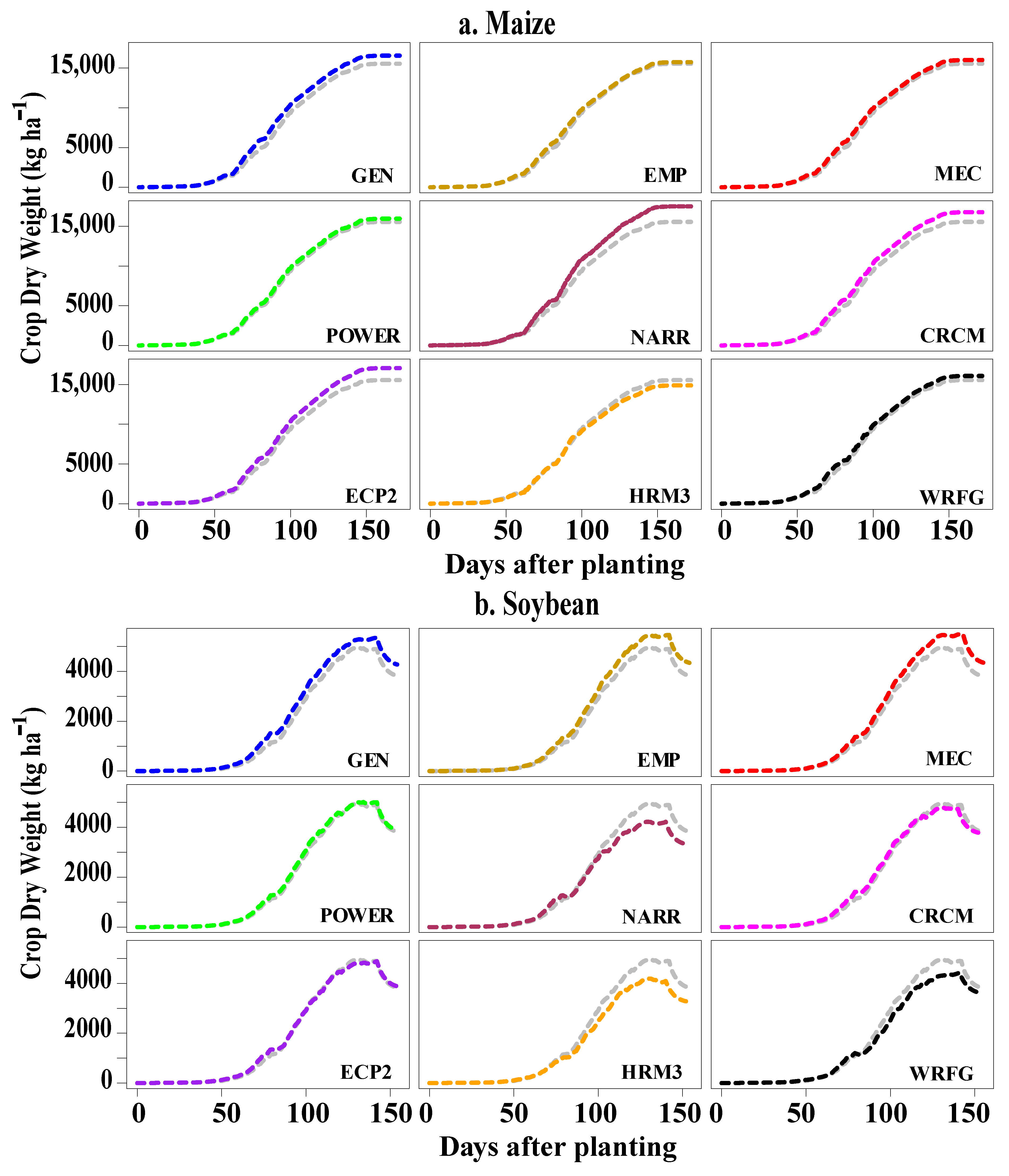

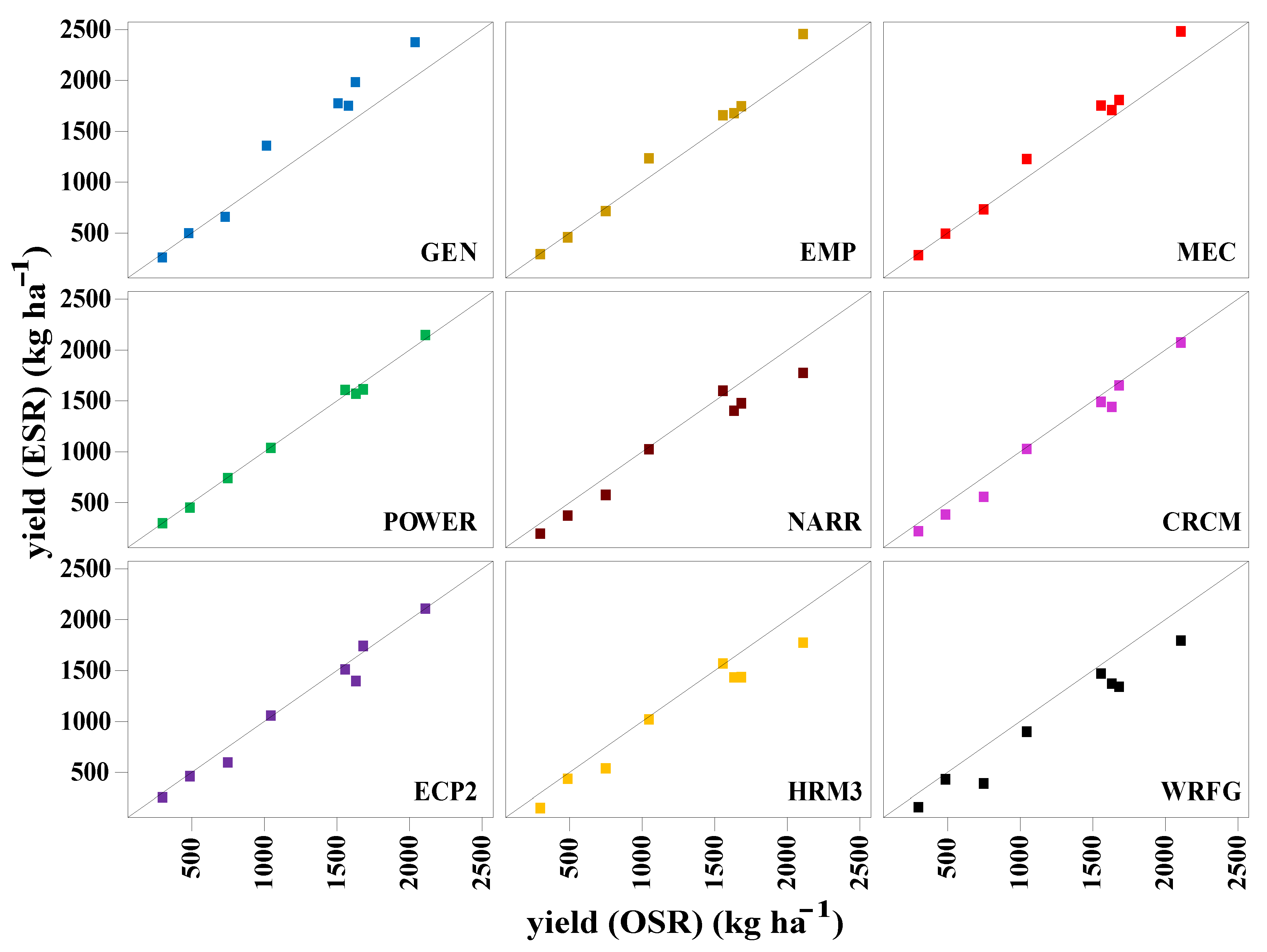

| Management Rules | Maize | Soybean |
|---|---|---|
| Plant populations | 6 plants per m2 | 20 plants per m2 |
| Cultivar | Short-season cultivar Base temperature: 8 °C Thermal time for juvenile phenological stages (P1): 200 degree days Thermal time from silking to maturity (P2): 685 degree days | Generic Group 2 |
| Planting dates | Automatically when simulated 5 cm soil temperature after 1 April is ≥10 °C | Automatically when simulated 5 cm soil temperature after 1 April is ≥10 °C |
| Harvest | At physiological maturity | At physiological maturity |
| Month | GEN | EMP | MEC | POWER | NARR | CRCM | ECP2 | HRM3 | WRFG |
|---|---|---|---|---|---|---|---|---|---|
| Difference in monthly mean daily solar radiation (percent) | |||||||||
| January | 19.0 | −3.7 | −1.6 | 8.0 | 39.2 | −3.7 | 21.5 | −4.9 | 22.0 |
| February | 6.1 | 5.6 | −6.5 | 4.7 | 30.8 | 6.2 | 17.6 | −3.8 | 19.9 |
| March | 4.1 | −2.2 | −6.6 | −1.0 | 20.4 | 10.1 | 11.3 | −3.0 | 26.7 |
| April | 17.0 | 2.0 | 6.2 | 0.9 | 22.6 | 14.3 | 13.3 | 10.1 | 28.0 |
| May | 18.9 | 2.9 | 10.1 | 2.4 | 27.9 | 10.6 | 8.9 | 10.8 | 25.7 |
| June | 6.3 | −5.0 | −2.1 | −1.4 | 21.0 | 12.3 | 5.8 | 16.5 | 21.2 |
| July | 1.1 | −8.4 | −6.0 | −3.4 | 19.9 | 11.5 | 3.7 | 12.7 | 21.7 |
| August | 4.9 | −3.6 | −4.9 | 0.3 | 25.3 | 16.5 | 13.8 | 22.7 | 31.5 |
| September | 10.9 | 4.1 | −3.3 | 3.7 | 29.1 | 13.0 | 16.3 | 19.5 | 30.1 |
| October | 16.8 | 14.0 | −2.3 | 8.2 | 33.2 | 5.1 | 20.1 | 20.7 | 28.2 |
| November | 33.3 | 21.3 | 2.5 | 21.7 | 54.9 | 11.4 | 32.2 | 20.7 | 43.6 |
| December | 24.4 | −9.5 | 0.6 | 21.2 | 55.9 | 3.0 | 31.0 | 13.4 | 32.6 |
| Difference in monthly standard deviation of daily solar radiation (percent) | |||||||||
| January | −72.8 | 9.7 | −25.9 | 8.0 | −14.7 | 13.6 | −12.5 | 12.7 | 12.5 |
| February | −84.3 | −28.5 | −33.3 | 4.7 | −21.1 | 14.4 | −13.5 | 14.0 | 3.3 |
| March | −81.8 | −34.4 | −34.7 | −1.0 | −11.9 | 13.5 | −10.3 | 20.0 | −1.3 |
| April | −78.4 | −37.3 | −36.2 | 0.9 | −14.1 | −1.6 | −15.5 | 8.7 | −4.2 |
| May | −76.3 | −34.4 | −36.0 | 2.4 | −13.4 | 4.0 | −10.7 | 15.8 | −5.7 |
| June | −77.7 | −31.8 | −33.1 | −1.4 | −15.0 | −4.1 | −10.3 | −0.5 | 1.3 |
| July | −84.9 | −35.1 | −38.8 | −3.4 | −16.1 | 2.7 | −6.4 | 11.0 | 3.6 |
| August | −77.0 | −23.8 | −30.0 | 0.3 | −17.5 | −6.9 | −4.6 | −7.8 | −9.8 |
| September | −77.4 | −20.5 | −33.9 | 3.7 | −16.9 | −5.7 | −9.8 | 2.9 | −11.3 |
| October | −73.0 | −1.6 | −28.5 | 8.2 | −11.1 | 1.1 | −8.3 | 7.9 | 0.2 |
| November | −78.2 | 2.3 | −37.9 | 21.7 | −14.7 | 10.2 | −8.1 | 11.7 | 8.8 |
| December | −58.4 | 38.5 | −29.4 | 21.2 | −21.3 | 14.2 | −16.5 | 5.9 | 10.9 |
| Radiation Sources | Maize | Soybean | ||||
|---|---|---|---|---|---|---|
| Difference in Mean (%) | Difference in Standard Deviation (%) | Correlation | Difference in Mean (%) | Difference in Standard Deviation (%) | Correlation | |
| GEN | 2.63 | −2.29 | 0.99 | 15.58 ** | 24.37 | 0.99 |
| EMP | 4.37 | 1.18 | 0.98 | 7.23 * | 15.11 | 0.99 |
| MEC | 1.54 | −8.67 | 0.99 | 9.80 ** | 17.56 | 0.99 |
| POWER | 1.12 | 9.39 | 0.99 | −0.81 | 1.00 | 0.99 |
| NARR | 3.34 | 7.57 | 0.99 | −11.78 *** | −6.66 | 0.98 |
| CRCM | 6.09 * | 4.21 | 0.98 | −7.32 *** | 3.21 | 0.99 |
| ECP2 | 4.12 * | 5.32 | 0.99 | −4.37 | 2.09 | 0.99 |
| HRM3 | 3.33 | 1.69 | 0.97 | −12.48 *** | −6.82 | 0.98 |
| WRFG | 6.73 * | 9.55 | 0.98 | −17.73 *** | −7.28 | 0.98 |
| Radiation Source | Strengths | Limitations |
|---|---|---|
| Traditional Methods | ||
| Weather Generator (WeatherMan) |
|
|
| Empirical Model (modified from Ball et al. [20]) |
|
|
| Mechanistic Model (modified from Hunt et al. [21]) |
|
|
| Non-Traditional Methods | ||
| Satellite estimation (POWER) |
|
|
| Regional reanalysis (NARR) |
|
|
| Regional climate model simulations (CRCM, ECP2, HRM3, WRFG) |
|
|
Publisher’s Note: MDPI stays neutral with regard to jurisdictional claims in published maps and institutional affiliations. |
© 2020 by the authors. Licensee MDPI, Basel, Switzerland. This article is an open access article distributed under the terms and conditions of the Creative Commons Attribution (CC BY) license (http://creativecommons.org/licenses/by/4.0/).
Share and Cite
Perdinan; Winkler, J.A.; Andresen, J.A. Evaluation of Multiple Approaches to Estimate Daily Solar Radiation for Input to Crop Process Models. Atmosphere 2021, 12, 8. https://doi.org/10.3390/atmos12010008
Perdinan, Winkler JA, Andresen JA. Evaluation of Multiple Approaches to Estimate Daily Solar Radiation for Input to Crop Process Models. Atmosphere. 2021; 12(1):8. https://doi.org/10.3390/atmos12010008
Chicago/Turabian StylePerdinan, Julie A. Winkler, and Jeffrey A. Andresen. 2021. "Evaluation of Multiple Approaches to Estimate Daily Solar Radiation for Input to Crop Process Models" Atmosphere 12, no. 1: 8. https://doi.org/10.3390/atmos12010008
APA StylePerdinan, Winkler, J. A., & Andresen, J. A. (2021). Evaluation of Multiple Approaches to Estimate Daily Solar Radiation for Input to Crop Process Models. Atmosphere, 12(1), 8. https://doi.org/10.3390/atmos12010008



